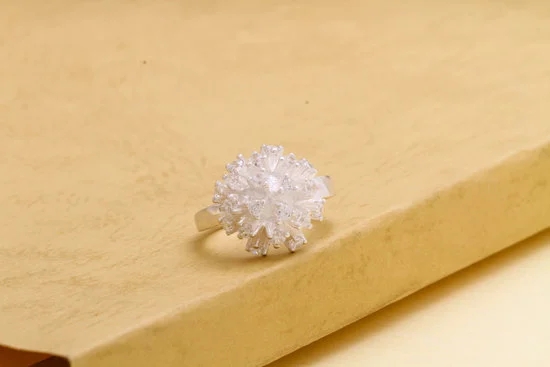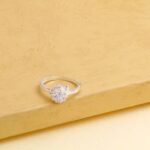When it comes to fashion jewelry, nothing can be more disheartening than seeing your favorite pieces lose their shine and charm due to tarnishing. Tarnishing occurs as a result of various factors such as exposure to moisture, chemicals, or even improper storage. However, with proper care and knowledge, you can prevent tarnishing and keep your precious fashion jewelry looking brand new for years to come.
In this article, we will delve into the causes of tarnishing in fashion jewelry and explore effective methods to combat it. We will discuss the importance of selecting non-tarnishing materials and provide tips on proper storage techniques that can protect your jewelry collection from tarnish. Additionally, we will shed light on the harmful effects of moisture and chemicals on your jewelry and offer practical solutions for limiting exposure.
Furthermore, we will also guide you through step-by-step instructions on how to clean and maintain your fashion jewelry regularly to prevent tarnishing. We will introduce the concept of using protective coatings or sealants as an additional layer of defense against tarnish. Lastly, we will touch upon seeking professional care when necessary and share insights on why it may be essential for preserving the beauty and longevity of your cherished pieces.
So if you’re tired of dealing with discolored or dull fashion jewelry, read on as we equip you with valuable knowledge and actionable tips to keep your collection gleaming and free from tarnish. Let’s embark on this journey together towards maintaining the allure of your treasured accessories.
Understanding the Causes of Tarnishing
Tarnishing is a common issue that fashion jewelry enthusiasts face, and understanding the causes of tarnishing is essential in preventing it. There are several factors that contribute to the tarnishing of fashion jewelry, and being aware of them can help you take proactive measures to keep your jewelry looking like new for longer.
One of the primary causes of tarnishing is exposure to air and moisture. When metal jewelry comes into contact with oxygen and humidity, a chemical reaction occurs that results in tarnish. This process is accelerated when the jewelry is exposed to sweat or other liquids containing chemicals such as perfume, lotion, or cleaning agents.
Another factor contributing to tarnishing is the type of metal used in the jewelry. Some metals, particularly those with higher copper content like brass or bronze, are more prone to tarnish than others. Silver and gold-plated jewelry are also susceptible to tarnish over time.
| Causes of Tarnishing | Effects on Jewelry |
|---|---|
| Exposure to air and moisture | Tarnish formation |
| Contact with chemicals (perfume, lotion, cleaning agents) | Tarnish formation |
| Metals with higher copper content (brass, bronze) | Higher susceptibility to tarnish |
| Silver and gold-plated jewelry | Potential for tarnish over time |
To prevent tarnishing, it is important to choose fashion jewelry made from non-tarnishing materials. Stainless steel, titanium, and rhodium-plated metals are known for their resistance to tarnish. Additionally, opting for jewelry with a protective coating or sealant can provide an extra layer of defense against tarnishing.
With a basic understanding of the causes of tarnishing in fashion jewelry, you can now take steps to mitigate these factors and prolong the lifespan of your favorite pieces. In the next section, we will discuss proper storage techniques that help prevent tarnishing and maintain the quality and appearance of your fashion jewelry.
Choosing the Right Materials
Choosing the right materials for your fashion jewelry is crucial in preventing tarnishing and ensuring that your pieces remain in pristine condition. By selecting jewelry made from non-tarnishing materials, you can significantly decrease the risk of tarnishing and extend the longevity of your accessories.
The Role of Base Metals
One key factor to consider when choosing fashion jewelry is the base metal used. Base metals are often used as a foundation for creating various types of jewelry, including gold and silver-plated pieces. However, not all base metals are created equal when it comes to tarnish resistance. Some common base metals prone to tarnishing include copper, brass, and nickel.
To minimize the risk of tarnishing, opt for fashion jewelry made from stainless steel or sterling silver. These materials are known for their durability and resistance to tarnish. Stainless steel not only offers excellent corrosion resistance but is also hypoallergenic, making it suitable for those with sensitive skin. Sterling silver, on the other hand, has a higher silver content and is less likely to tarnish compared to lower-quality silver alloys.
Alternative Non-Tarnishing Materials
Aside from stainless steel and sterling silver, there are other non-tarnishing materials available that can be used for fashion jewelry. Titanium is one such material that boasts exceptional strength as well as resistance to corrosion and tarnish. It is lightweight, durable, and often used in high-end designer jewelry.
Another popular option is platinum or white gold plating. These precious metals have excellent resistance against tarnishing compared to traditional gold plating.
When shopping for fashion jewelry, always check the labeling or product descriptions to ensure that you are purchasing pieces made from non-tarnishing materials. This will help guarantee that your jewelry remains beautiful and lustrous year after year.
Taking Care of Your Jewelry
While selecting non-tarnishing materials is essential, it is also crucial to maintain and care for your fashion jewelry properly. Regular cleaning, storage techniques, and avoiding exposure to harmful substances are all necessary steps in preventing tarnishing. By incorporating these measures into your jewelry routine, you can ensure that your fashion pieces stay dazzling and tarnish-free for a considerable time.
Proper Storage Techniques
Storing your fashion jewelry properly is crucial in preventing tarnishing and keeping them in good condition for a long time. Here are some tips on how to store your fashion jewelry effectively:
- Use Jewelry Boxes and Organizers: Invest in a good quality jewelry box or organizer that has separate compartments for different pieces of jewelry. This will help prevent tangling and scratching of the pieces, reducing the risk of tarnishing.
- Keep Jewelry Individually: Store each piece of jewelry separately to avoid any direct contact between them. This will minimize friction and prevent scratching, which can expose the underlying metal to air and moisture, leading to tarnishing.
- Use Anti-Tarnish Strips or Pouches: Consider using anti-tarnish strips or pouches when storing your fashion jewelry. These strips or pouches are designed to absorb moisture and reduce oxidation, helping prevent tarnishing. Place one in the jewelry box or organizer to protect all the pieces inside.
- Avoid Humidity and Dampness: Moisture is one of the main causes of tarnishing. Store your fashion jewelry in a dry place away from humidity, such as a closed drawer or shelf, rather than leaving them exposed on countertops or bathroom sinks where they can come into contact with water frequently.
- Limit Exposure to Air: Oxygen in the air accelerates the process of oxidation, leading to tarnishing. Close any clasps or fastenings on your jewelry properly before storing them to limit their exposure to air.
6.Your Turntable/cabinet should be located at least 2 feet away from heating sources like radiators and out of direct sunlight as these heat sources can damage vintage records.
Get competition prices + free e-books if you book now.
7.Post-holiday sale for new customers who purchase our products.
Our products consistently receive 5-star reviews and are produced responsibly
Overall, by following these proper storage techniques, you can significantly reduce the risk of tarnishing in your fashion jewelry. Taking care of your jewelry in the way it deserves will help preserve its beauty and prolong its lifespan.
Limiting Exposure to Moisture
Understanding the Effects of Moisture on Jewelry
When it comes to preventing tarnishing in your fashion jewelry, limiting exposure to moisture is crucial. Moisture has a detrimental effect on jewelry because it can trigger chemical reactions that accelerate tarnishing. Many people may not realize it, but everyday activities such as showering, swimming, or even sweating can contribute to the tarnishing process. Water and humidity can react with metals in the jewelry, causing them to oxidize and lose their luster over time.
Tips for Protecting Your Jewelry from Moisture
To protect your fashion jewelry from moisture and preserve its shine, there are several precautions you can take:
- Remove Jewelry Before Contact with Water: It’s essential to remove your jewelry before participating in any water-related activities. Whether you’re washing your hands, doing household chores, or going for a swim, make sure to take off your jewelry and store it in a safe place.
- Dry Thoroughly: After removing your jewelry, be sure to dry it thoroughly before putting it away. Use a soft cloth or towel to gently pat dry each piece of jewelry individually. Pay extra attention to areas that may trap moisture, such as clasps or crevices.
- Avoid Humid Environments: If possible, store your fashion jewelry in a dry environment with minimal humidity. Excessive moisture in the air can speed up the tarnishing process. Consider using dehumidifiers or storing your jewelry in air-tight containers with silica gel packets.
- Use Anti-Tarnish Products: Another way to limit exposure to moisture is by utilizing anti-tarnish products such as anti-tarnish strips or pouches when storing your fashion jewelry. These products are designed to absorb moisture and prevent tarnishing.
By following these tips to limit exposure to moisture, you can significantly extend the lifespan of your fashion jewelry and keep it looking beautiful for years to come. Remember, prevention is key when it comes to combating tarnishing caused by moisture.
Avoiding Chemical Interactions
Chemicals can have a significant impact on the tarnishing of fashion jewelry. It is essential to be aware of the common chemicals that can cause tarnishing and take necessary precautions to avoid them. Here are some key chemicals to watch out for and how to prevent them from interacting with your jewelry:
- Perfumes and Cosmetics: Many perfumes, lotions, and cosmetics contain harsh chemicals that can react with the metal in your jewelry, leading to tarnishing. To prevent this, apply these products before putting on your jewelry and allow sufficient time for them to dry or absorb into your skin.
- Household Cleaning Products: Cleaning agents like bleach, ammonia, and chlorine can corrode or damage the metal in your jewelry, resulting in tarnishing. It is important to remove your jewelry before using any cleaning products or engaging in activities involving these chemicals.
- Sweat and Body Oils: Perspiration and natural body oils contain acids that can accelerate the tarnishing process. Remove your jewelry during intense physical activities or when you know you’ll be sweating excessively.
- Saltwater and Chlorinated Water: Exposure to saltwater or chlorinated water, such as that found in swimming pools or hot tubs, can cause rapid corrosion of metal jewelry, leading to tarnishing. Always remove your jewelry before swimming or soaking in such waters.
To prevent chemical interactions with your fashion jewelry:
- Put on your jewelry after applying perfumes, lotions, or cosmetics.
- Remove your jewelry before using household cleaning products.
- Take off your jewelry during intense physical activities.
- Avoid wearing jewelry in saltwater or chlorinated water.
By being mindful of these chemical interactions and taking necessary precautions, you can significantly reduce the chances of tarnishing in your fashion jewelry and keep it looking pristine for longer periods.
Regular Cleaning and Maintenance
Regular cleaning and maintenance are essential to prevent tarnishing and keep your fashion jewelry looking its best. By following a step-by-step guide, you can ensure that your jewelry stays tarnish-free and maintains its dazzling shine.
- Gather Your Supplies: Start by collecting all the necessary supplies for cleaning your fashion jewelry. You will need a soft cloth or microfiber cloth, lukewarm water, mild soap or jewelry cleaner specifically formulated for fashion jewelry, a soft-bristled toothbrush or jewelry brush, and a non-abrasive polishing cloth.
- Remove Any Excess Dirt or Residue: Before cleaning your jewelry, gently wipe away any excess dirt or residue using a soft cloth. Be careful not to use force as it may scratch delicate surfaces.
- Prepare a Cleaning Solution: In a small bowl, mix lukewarm water with a few drops of mild soap or jewelry cleaner specifically designed for fashion jewelry. Avoid using harsh chemical cleaners as they may damage the metal or stones.
- Soak and Clean: Place your fashion jewelry in the cleaning solution and let it soak for a few minutes. Gently agitate the piece to dislodge any dirt or grime. Use a soft-bristled toothbrush or jewelry brush to clean hard-to-reach areas without scratching the surface.
- Rinse Thoroughly: After cleaning, rinse the jewelry under lukewarm water to remove any remaining soap residue. Be sure to handle delicate pieces carefully to avoid dropping them down the drain.
- Dry and Polish: Pat dry your fashion jewelry using a clean, soft cloth until it is completely dry. Once dry, use a non-abrasive polishing cloth to gently buff the metal parts of the piece to restore its shine.
- Store Properly: After cleaning and drying your fashion jewelry, store it properly to protect it from humidity, dust, and scratches. Consider using separate compartments in a jewelry box or investing in a jewelry organizer with individual slots for each piece.
Regular cleaning and maintenance should be a part of your jewelry care routine to prevent tarnishing. By following these steps, you can keep your fashion jewelry looking new and vibrant for years to come. Remember to handle your pieces with care and avoid exposing them to moisture, harsh chemicals, or excessive heat to preserve their beauty and prevent tarnishing.
Protective Coatings and Sealants
Protective coatings and sealants are excellent options for preventing tarnishing in fashion jewelry. These products create a barrier between the jewelry and external factors that cause tarnishing, such as moisture and chemicals. By applying a protective coating or sealant, you can prolong the life of your fashion jewelry and keep it looking shiny and new.
There are several types of protective coatings and sealants available on the market. One popular option is clear nail polish. Simply apply a thin coat of clear nail polish to the surface of your jewelry, making sure to cover all areas thoroughly. The nail polish will form a protective layer that prevents tarnishing from occurring.
Another option is using specific jewelry sealants or coatings specifically designed for this purpose. These products are often made with ingredients that create a strong shield against tarnishing while maintaining the original appearance of the jewelry. Before applying any sealant or coating, it’s important to read the instructions carefully to ensure proper use and compatibility with your jewelry.
When applying protective coatings or sealants, it’s essential to clean your fashion jewelry thoroughly beforehand. Use a mild soap and warm water solution to gently clean the piece, then dry it completely before applying any coating. This will remove any dirt or debris that could potentially be sealed in by the coating, leading to discoloration or damage over time.
It’s worth noting that protective coatings and sealants may need to be reapplied periodically, depending on their longevity and wear. Factors such as everyday wear, exposure to moisture or chemicals, and regular cleaning may affect the effectiveness of these products over time. By regularly inspecting your fashion jewelry and reapplying protective coatings as needed, you can ensure its continued protection against tarnishing.
Professional Care and Restoration
Fashion jewelry, like any other type of jewelry, requires proper care to maintain its quality and prevent tarnishing. While regular cleaning and maintenance can go a long way in preserving the condition of your fashion jewelry, there are occasions when seeking professional care and restoration becomes necessary.
One instance where professional care is beneficial is when your fashion jewelry has intricate designs or delicate components. These pieces often require specialized cleaning techniques that are best handled by professionals. They have the knowledge and experience to clean these intricate pieces without causing damage or compromising the design.
Additionally, seeking professional care may be necessary if your fashion jewelry has experienced significant damage or wear over time. Professionals have access to specialized tools and techniques that allow them to repair broken clasps, mend chains, restring beads, replace missing gemstones, or resize rings. By entrusting your damaged or worn-out jewelry to experts, you can restore its original beauty and extend its lifespan.
Moreover, professional jewelers can provide advice on how to properly store and maintain your fashion jewelry. They can suggest preventive measures such as applying protective coatings or sealants that act as barriers against tarnishing. Their expertise ensures that you receive accurate guidance tailored specifically to your jewelry’s materials and condition.
Conclusion
In conclusion, keeping your fashion jewelry tarnish-free is essential to ensure its longevity and maintain its aesthetic appeal. Throughout this article, we have explored the various factors that contribute to tarnishing, as well as provided tips and techniques for preventing it.
One of the key takeaways from this discussion is the importance of choosing jewelry made from non-tarnishing materials. By selecting pieces made from stainless steel, sterling silver, or gold-filled metals, you can significantly reduce the risk of tarnishing. Additionally, proper storage techniques such as using individual compartments or anti-tarnish bags will help protect your jewelry from exposure to air and moisture.
Moisture and chemical interactions are other significant contributors to tarnishing. Limiting exposure to moisture by removing your jewelry before showering or swimming can prevent oxidation and discoloration. Furthermore, avoiding contact with chemicals like perfumes, lotions, and cleaning products will help maintain the integrity of your fashion jewelry.
Regular cleaning and maintenance are crucial in preventing tarnishing. Following a step-by-step guide for cleaning your fashion jewelry using gentle solutions will keep it looking shiny and new. Additionally, considering applying protective coatings or sealants can provide an extra layer of defense against tarnishing.
Lastly, knowing when professional care and restoration might be necessary is also essential. If you notice severe tarnishing or damage to your fashion jewelry that you cannot address on your own, seeking the assistance of a professional jeweler may be beneficial.
By implementing these tips and techniques discussed throughout this article into your routine care for fashion jewelry, you can ensure its beauty remains untarnished. Remember that prevention is key when it comes to maintaining the quality and appearance of your favorite pieces.
So make sure to choose the right materials, store them properly, limit exposure to moisture and chemicals, clean regularly, consider protective coatings where applicable, and seek professional care when needed. With these strategies in place, you can enjoy dazzling fashion jewelry for years to come.
Frequently Asked Questions
What can I put on cheap jewelry to keep it from tarnishing?
To prevent cheap jewelry from tarnishing, there are a few options you can try. Consider applying a thin layer of clear nail polish to the surfaces of the jewelry that come into direct contact with your skin. This protective coating acts as a barrier between the metal and your skin’s natural oils, slowing down the tarnishing process.
Another option is to keep your jewelry in a sealed plastic bag or container when you’re not wearing it, as this helps to limit its exposure to air and moisture, which can accelerate tarnishing. Additionally, avoid exposing your cheap jewelry to harsh chemicals such as perfumes, lotions, or cleaning products, since these can cause discoloration.
How do you clean costume jewelry without tarnishing it?
Cleaning costume jewelry without causing tarnish requires gentle methods and careful consideration of the materials involved. Start by using a soft cloth or cotton swab dampened with warm water to gently wipe away any dirt or residue on the surface of the jewelry. If needed, a mild soap solution can be applied sparingly for deeper cleaning, but ensure that it is fully rinsed off afterwards.
Avoid immersing costume jewelry in water for extended periods as it may seep into gaps and cause irreparable damage. It’s crucial to dry the jewelry thoroughly after cleaning to prevent any moisture from contributing to tarnish formation.
Can you fix tarnished fake jewelry?
While it’s not always possible to completely restore tarnished fake jewelry back to its original condition, there are steps you can take to improve its appearance. One method involves creating a solution of warm water and mild dish soap, then gently scrubbing the piece with a soft toothbrush or cloth soaked in this mixture. Rinse thoroughly afterwards and pat dry with a clean cloth.
Be cautious not to scrub too vigorously or use abrasive cleaners as this can further damage the fake jewelry’s surface coating or plating. If this doesn’t provide satisfactory results, consider taking your tarnished fake jewelry to a professional jeweler who may have additional methods or techniques to improve its appearance.

Welcome to my jewelry blog! My name is Sarah and I am the owner of this blog.
I love making jewelry and sharing my creations with others.
So whether you’re someone who loves wearing jewelry yourself or simply enjoys learning about it, be sure to check out my blog for insightful posts on everything related to this exciting topic!





